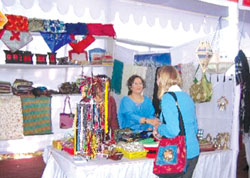|
|
Last week, there was a Nepal Trade Fair in Dhaka. It was organised by the Embassy of Nepal and Nepal's Ministry of Industry's Trade and Export Promotion Centre (TEPC). Ten exhibitors from the handicraft industry sold wares such as silver jewellery, carved wooden windows, pashmina shawls, lokta paper products, handmade bags, and herbal tea.
"Dhaka is only an hour's flight from Kathmandu, and Bangladesh presents a globally emerging market," said Ramesh Prasad Khanal, charge d'affaires at the embassy. "About 1,500 Nepali students are studying medicine, nursing, public health, and engineering here, and most well-to-do Bangladeshis speak fondly of their visits to Nepal. Given these ties, it's only fitting that we try to expand trade between our two countries. This fair, organised for the first time since 2001, is a step in that direction."
Narayan P Shrestha, executive director of TEPC, said the fair was meant to give exposure to small entrepreneurs. "Our export value to Bangladesh was about Rs. 240 million last year. That makes Bangladesh our 15th major trading partner, after Turkey and Bhutan."
Exhibitors' enthusiasm was somewhat tempered. Though they appreciated the organisers' hard work and credited the embassy staff with leveraging the support of Dhaka-based Nepali professionals and students, most said the turnout-about 5,000 visitors over the four-day period-was lower than what they expected.
"Most buyers are foreigners from diplomatic and aid communities," one said. "I wish there were more Bangladeshi buyers so we could understand their demands and tastes," added another. "Bangladeshis look for foodstuff-lentils, noodles, dairy products-not just handicrafts, where they have an edge," said a third. Khanal was responsive, reassuring us that, "Next time, we'll host fairs in commercial venues and not in the embassy premises."
Visiting the fair, I was charmed by its haat feel. You could close your eyes and imagine the fair's business content being similar to that of any Nepali trade fair conducted anywhere. In, say, 1997 or 1987. While the world has moved on to branding countries and their products in an integrated manner for trade, investments, and tourism, this fair was a stark reminder that our approach to foreign trade remains naively cottage industry-esque.
Sure, that approach has its own appeal. But to enhance a country's trading profile in increasingly sophisticated and brutally competitive international markets, herding relatively unspecialised small businesses with seemingly undifferentiated handicraft products seems like an expensively outdated way. Other than raise small-volume transactions, such an approach does little to help Nepali businesses expand production, attract investment, use better technologies, and generate employment.
We need to re-think and improve the content of our international trade fairs. The idea is to get more bang for our limited buck, so that we imprint a compelling 'Open for Business and Leisure' stamp on Nepal's image. Nepal Tourism Board, for instance, can't just send random posters, and expect to sell leisure destinations to wealthy Bangladeshis who are not interested in paragliding or mountain climbing. Our entrepreneurs should not take part in fairs without understanding what buyers actually look for. Likewise, government officers need to partner with private sector players to organise food festivals and cultural events and to start here's-how-easily-you-invest-in-Nepal conversations.
Of course, such an integrated approach to trade fairs is easier talked about than done. But unless we become strategic about what we want to sell to others by consistently presenting Nepal in a certain light, merely organising trade fairs abroad in a business-as-usual manner may just be an expensive way of recreating Basantapur's tourist market on foreign soil at taxpayers' expense.




